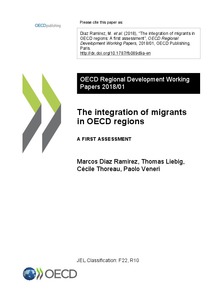The integration of migrants in OECD regions. A first assessment
"This paper provides an assessment of the presence of migrants, their characteristics and integration outcomes across OECD regions, based on a new OECD database on immigrant integration at the regional level. It reveals the wide diversity of the presence of migrants within countries, as well as...
| Main Authors: | , , , |
|---|---|
| Institution: | ETUI-European Trade Union Institute |
| Format: | TEXT |
| Language: | English |
| Published: |
Paris
2018
OECD |
| Subjects: | |
| Online Access: | https://www.labourline.org/KENTIKA-19399277124911174599-The-integration-of-migrants-in.htm |
| Summary: | "This paper provides an assessment of the presence of migrants, their characteristics and integration outcomes across OECD regions, based on a new OECD database on immigrant integration at the regional level. It reveals the wide diversity of the presence of migrants within countries, as well as the specific patterns observed in the way migrants locate and integrate in society across regions. For example, migrants tend to be more spatially concentrated in capital-city and metropolitan regions than the native-born population. What is more, highly-educated migrants are more likely to locate in the same regions where the highly-educated natives concentrate, a trend that is not observed for the low-educated foreign-born. Integration outcomes of migrants, relative to the native-born, are measured through a variety of labour market and housing indicators. The paper also provides preliminary findings on public attitudes towards migrants across regions, which suggest that attitudes tend to be more positive in regions with larger shares of foreign-born population." |
|---|---|
| Physical Description: | 47 p. Digital |

